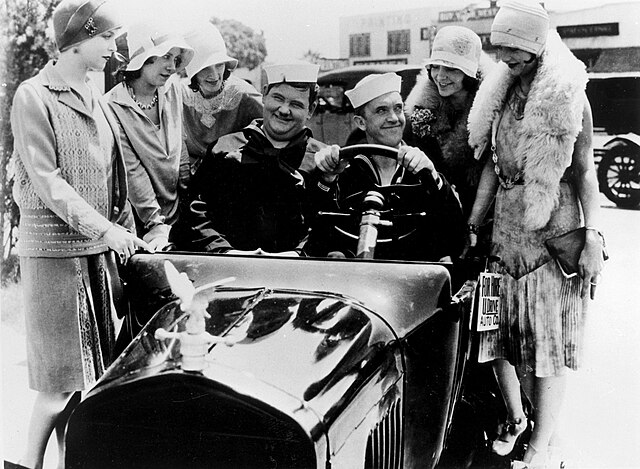New Package of Laurel and Hardy Silents Offers Chance To Watch as Legendary Comedy Team’s Foibles Are Established
‘Laurel and Hardy: Year Two’ includes 10 comedy shorts of varying quality, each of which runs about 20 minutes in length. Even the best are loose-limbed, ramshackle, on-the-fly efforts.

Among the bonus materials on Flicker Alley’s new Blu-ray set, “Laurel and Hardy: Year Two; The Newly Restored 1928 Silents,” is a short film from the previous year, “Eve’s Love Letters,” that was Stan Laurel’s penultimate effort as a solo performer.
He doesn’t receive top billing: that belongs to Agnes Ayres, an actress likely best remembered as playing opposite Rudolph Valentino in “The Sheik” (1921). Laurel is listed fourth in the credits, but he’s essentially Ayres’s co-star in a by-the-book farce about marital duplicity.
He’s not the Stan that history has come to know, not yet. Rhythm is everything in comedy, and every comedian has his own rhythm; unlike many of their peers, Laurel and Hardy abjured speed for deliberation. If Ayres proves sprightly in “Eve’s Love Letters,” so, too, does an atypical Laurel.
Theory has it that it was the dawdling, sometimes fussy cadence of a born-and-bred southerner — Hardy hailed from Harlem, Georgia — that halted his partner’s hyperactivity. If so, Stan had Ollie to thank for righting a solo career that looked, at the time, to be faltering.
Laurel and Hardy had appeared together in films for Hal Roach Studios since 1921, but their first official pairing as a team occurred in October 1927 with “The Second Hundred Years.” Their chemistry had been recognized and encouraged by studio boss Roach, in-house director Leo McCarey, and not least Laurel himself. The writing was on the wall during the making of “Eve’s Love Letters”: Among the characters in the picture is one dubbed Oliver Hardy. You don’t just pull a name like that out of a derby hat.
“Laurel and Hardy: Year Two” includes 10 comedy shorts, each of which runs about 20 minutes in length. They’re of varying quality. The pair made a lot of movies, just a tad more than 100. Even the best of the shorts — “Wrong Again” (1929), say, or “The Music Box” (1932) — are loose-limbed, ramshackle, on-the-fly efforts. This particular set finds them riffing, sometimes wildly, and, in the process, establishing each other’s foibles. Skirting the arbitrary has never been so genial.

Besides, don’t we go to Laurel and Hardy for, you know, Laurel and Hardy? Notwithstanding McCarey — who would, it bears reminding, become a director of no small significance — and comedy journeymen like Clyde Bruckman and James Parrot, the shorts are, for the most part, point-and-shoot ventures in which the camera takes a distinct second place to the shenanigans of the two stars. Laurel and Hardy are Exhibit A for those who prefer affability over le cinéma.
“Year Two” includes shorts that are more notable for telltale iconography than sustained comedy. Take “Two Tars”: Tell me that Stan and Ollie don’t rock the women’s headwear they inadvertently acquire as much as their tailor-made sailor suits? The film’s fender-bender denouement — some wags have suggested it as inspiration for Jean Luc-Godard’s car wreck of a movie, “Weekend” (1967) — hasn’t aged well, though it does close with a gag whose linearity recalls Jacques Tati at his most mathematical.
Some of the titles tell all, such as “Should Married Men Go Home?” and “We Faw Down”; others, like “Their Purple Moment” and “Habeas Corpus,” suggest shenanigans in a metaphorical manner.
“The Finishing Touch” has our heroes attempting to build a house in front of a hospital quiet zone. As you might imagine, their carpentry is suspect and their doings are loud. The wonder of Laurel and Hardy is how their humor retains its integrity — that is to say, it elicits laughter — even as each joke is blatantly telegraphed. If there is a tack on the floor, we know it will be stepped on; if there are nails to be hammered, we know they will be swallowed.
That’s not how comedy is supposed to work, but work it does in the hands, feet, heads, and backsides of these two indomitable clowns. “Year Three” is eagerly awaited; “Year Two” is history in the making.

